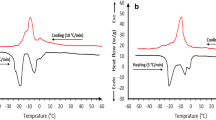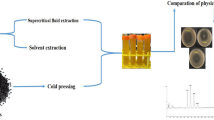Abstract
Garden cress (Lepidium sativum L.) is an edible, underutilised herb, grown mainly for its seeds in India. Physicochemical properties, minor components (unsaponifiable matter, tocopherols, carotenoids), fatty acid composition and storage stability of garden cress seed oil (GCO) were studied. Cold press, solvent and supercritical CO2 extraction methods were employed to extract the oil. The total oil content of garden cress (GC) seeds was 21.54, 18.15 and 12.60% respectively by solvent, supercritical CO2 and cold press methods. The physical properties of GCO extracted by the above methods were similar in terms of refractive index, specific gravity and viscosity. However, cold pressed oil showed low PV and FFA compared to the oil extracted by other methods. α-Linolenic acid (34%) was the major fatty acid in GCO followed by oleic (22%), linoleic (11.8%), eicosanoic (12%), palmitic (10.1%) erucic (4.4%), arachidic (3.4%) and stearic acids (2.9%). Oleic acid (39.9%) and α-linolenic acid (42.1%) were the predominant fatty acids at the sn-2 position. The total tocopherol and carotenoid content of GCO was 327.42 and 1.0 μmol/100 g oil, respectively. The oil was stable up to 4 months at 4 °C. Tocopherol and BHT offered the least protection, while ascorbyl palmitate (200 ppm) offered the maximum protection to the oil, when subjected to the accelerated oxidative stability test. Thus GCO can be considered as a fairly stable oil with a high content of α-linolenic acid.




Similar content being viewed by others
References
Nadkarni AK (1954) Indian Meteria Medica, with ayurvedic, unani-tibbi, siddha, allopathic, homeopathic, naturopathic and home remedies, appendices and indexes. 3rd edn. Dhootapeshwar Prakashan Ltd. Panvel pp 736–737
Kirthikar KR (1952) Lepidium sativum L. In: Kirthikar KR, Basu BD (eds), In: Indian Medicinal Plants 1: Lalith Mohan Basu. India pp 174–175
Uphof JCT (1959) Dictionary of economic plants, 2nd edn. Hafner Publishing, New York, p 308
Lotfy M, Aref H, Hussein AA (1957) The antioxidant properties of garden cress (Lepidium sativum) and wild mustard (Sinapsis arvensis) Oils. J Am Oil Chem Soc 34:96–100
Anonymous (1972) The Wealth of Indian Raw Materials Publication and information Directorate, vol 9. CSIR, New Delhi pp 71–72
Gil V, MacLeod AJ (1980) Studies on glucosinolate degradation in Lepidium sativum L. seed extracts. Phytochem 19:1369–1374
Kassie F, Rabot S, Uhl M, Huber W, Qin HM, Helma C, Hermann RS, Knasmüller S (2002) Chemoprotective effects of garden cress (Lepidium sativum) and its constituents towards 2-amino-3-methyl-imidazo[4, 5-f]quinoline (IQ)-induced genotoxic effects and colonic preneoplastic lesions. Carcinogenesis 23:1155–1161
Archana NP, Anita AM (2006) A study on clinical efficacy of Lepidium sativum seeds in treatment of bronchial asthma. Iran J Pharmacol Ther 5:55–59
Eddouks M, Maghrani M, Zeggwagh NA, Michel JB (2005) Study of the hypoglycaemic activity of Lepidium sativum L. aqueous extract in normal and diabetic rats. J Ethnopharmacol 97:391–395
Gupta S (2007) Effect of nutrients and plant density on growth and yield of garden cress (Lepidium sativum L.) M.Sc., Dissertation, University of Agricultural Sciences, Bangalore
Khan MI, Asha MR, Bhat KK, Khatoon S (2008) Studies on quality of coconut oil blends after frying potato chips. J Am Oil Chem Soc 85:1165–1172
AOCS (1998) Refractive index. Official methods and recommended practices of the American Oil Chemists’ Society, 5th edn. AOCS Press Champaign, Illinois
AOCS (1998) Specific gravity, refractive index. Official methods and recommended practices of the American Oil Chemists’ Society, 5th edn. AOCS Press Champaign, Illinois
AOCS (1998)Free fatty acids, refractive index. Official methods and recommended practices of the American Oil Chemists’ Society, 5th edn. AOCS Press Champaign, Illinois
International IDF standards International Dairy Federation, IDF-Square Vergote 41, Brussels, Sec. 74A: 1991
AOCS (1998) Saponification value. Official methods and recommended practices of the American Oil Chemists’ Society, 5th edn. AOCS Press Champaign, Illinois
Paquot C, Hanfenne A (1987) IUPAC standard methods for analysis of oils, fats and derivatives, 7th edn. International Union of Pure and Applied Chemistry, Blackwell Scientific, Oxford, pp 210–211
AOCS (1998) Unsaponifiable matter. Official methods and recommended practices of the American Oil Chemists’ Society, 5th edn. AOCS Press Champaign, Illinois
Morisson WR, Smith LM (1964) Preparation of fatty acid methyl esters and dimethylacetals from lipids with boron fluoride methanol. J Lipid Res 5:600–608
Hatman LJ, Kayden HJ (1979) A high performance liquid chromatographic method for the determination of tocopherol in plasma and cellular elements of the blood. J Lipid Res 20:639–645
Raju M, Varakumar S, Lakshminarayana R, Krishnakantha TP, Bhaskaran V (2007) Carotenoid composition and vitamin A activity of medicinally important green leafy vegetables. Food Chem 101:1598–1605
Fayaz H, Fereidoon S (2005) Structured lipids from high laurate canola oil and long chain omega-3 fatty acids. J Am Oil Chem Soc 82:731–736
Joyner NT, McIntyre JE (1938) The oven test as an index of keeping quality. Oil Soap 15:184–186
Appelquist LA (1971) Composition of seeds of Cruciferae oil crops. J Am Oil Chem Soc 48:851–859
Sinnecker P, Gomes MSO, Jose AGA, Lanfer-Marquez UM (2002) Relationship between color (instrumental and visual) and chlorophyll contents in soybean seeds during ripening. J Agric Food Chem 50:3961–3966
Budin JT, Breene WM, Putnam DH (1995) Some compositional properties of Camelina (Camelina sativa L. Crantz) seeds and oils. J Am Oil Chem Soc 72:309–315
Pearson D (1981) The chemical analysis of foods, 7th edn. Churchill Livingstone, Edinburgh, pp 504–530
White PJ (2007) Fatty acids in oils and seeds (vegetable oils). In: Chow CK (ed) Fatty acids in food and their health implications, 3rd edn. CRC Press, Florida, pp 228–229
Kapseu C, Parmentier M (1997) Fatty acid composition of some vegetable oils from Cameroon. Sci Aliments 17:325–331
Mathews S, Singhal RS, Kulakrni PR (1993) Some physicochemical characteristics of Lepidium sativum (haliv) seeds. Nahrung 1:69–71
Knothe G (2002) Structure indices in FA chemistry. How relevant is the iodine value? J Am Oil Chem Soc 79:847–854
Sumangala SG, Malleshi NG, GUO M (2004) Chemical composition of garden cress (Lepidium sativum) seeds and its fractions and use of bran as a functional ingredient. Plant Foods Hum Nutr 59:105–111
Aoyama T, Fukui K, Taniguchi K, Nagaoka S, Yamamoto T, Hashimoto Y (1996) Absorption and metabolism of lipids in rats depend on fatty acid isomeric position. J Nutr 126:225–231
Diwakar BT, Dutta PK, Lokesh BR, Naidu KA (2008) Bio-availability and metabolism of n-3 fatty acid rich garden cress (Lepidium sativum) seed oil in albino rats. Prostaglandins Leukot Essent Fatty Acids 78:123–130
Kamal-Eldin A, Anderson R (1997) A multivariate study of the correlation between tocopherol content and fatty acid composition in vegetable oils. J Am Oil Chem 74:375–380
Acknowledgements
The authors thank Dr. V. Prakash, Director, CFTRI, and Dr. P.V. Salimath, Head of the Department of Biochemistry and Nutrition, for their encouragement and support. Dr. K. Uday Shankar, Food Engineering Department, CFTRI, is acknowledged for his technical help in conducting supercritical CO2 extraction experiments. KAN gratefully acknowledges the financial assistance in the form of a project from the Indian Council of Medical research (ICMR), New Delhi. Financial support to Mr. B.T. Diwakar through Senior Research Fellowship from Council for scientific and Industrial Research (CSIR), New Delhi, India is also gratefully acknowledged.
Author information
Authors and Affiliations
Corresponding author
About this article
Cite this article
Diwakar, B.T., Dutta, P.K., Lokesh, B.R. et al. Physicochemical Properties of Garden Cress (Lepidium sativum L.) Seed Oil. J Am Oil Chem Soc 87, 539–548 (2010). https://doi.org/10.1007/s11746-009-1523-z
Received:
Revised:
Accepted:
Published:
Issue Date:
DOI: https://doi.org/10.1007/s11746-009-1523-z




